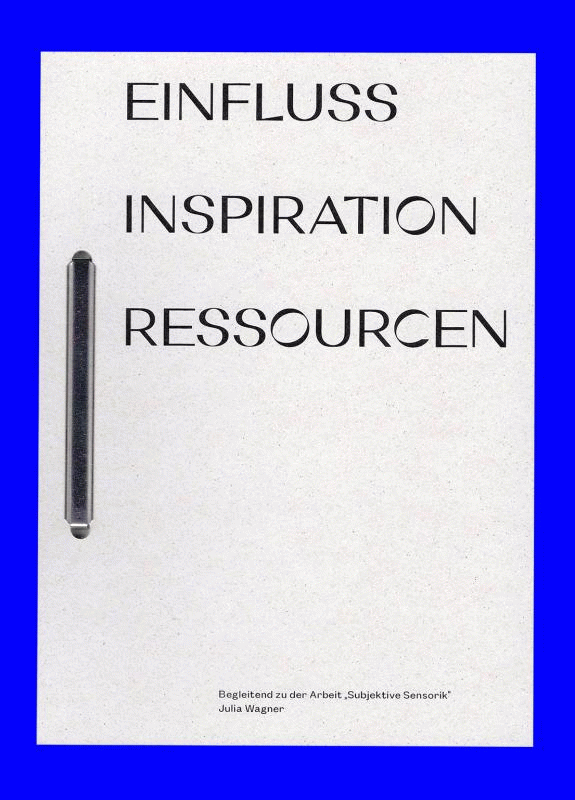

My initial goal for my diploma of representing, explaining, collecting, and archiving the project "Attention Recalibration", which I have changed over the course of the semester and became more concrete. I wanted to try to take the viewer into the process that led to the workshops, and in so doing, situate the project among peer projects and discussions. I had decided against depicting the process of one of the workshops I held in the exhibition, because on the one hand it depends very indidually on the external circumstances, the individual participants and the group dynamics, and on the other hand the process itself is extremely situational, and often not easily comprehensible to outsiders. In addition, the workshops are always held in mutual trust between all participants to allow for an open and honest dialogue that is not inhibited by being recorded.
Archiving was important to me for two reasons: I consider the entire project, and therefore my way of working, to be open source, open to anyone who is interested(1). By sharing not only results but also processes with each other, exciting collaborations can emerge, we can inspire each other and expand our own ways of working.
The second reason was that I would like to pursue this project after graduation. For future course participants or potential collaboration partners, it is exciting to see what has happened so far.
I divided my project into three stages: origin, execution/process and results. Since, as previously mentioned, I did not want to depict what happened with different workshop groups, I focused my archival work on origin and results.
Showing the interdependency of the projects origin was important to me, because the workshops were not written in a vacuum. I drew on conventional resources, such as literature, in my research, but I feel it is important to also mention those influences, inspirations, and resources that fall short in a conventional list of sources. The people and other creatures I read about, talked to and met, the places I worked at and thought about our project, and the projects that have similar topics to ours have made the workshop format "Attention Recalibration" what it is. A lot of hard work, research, creative energy and dillignece shaped this project, but external influences also shaped its form. With the archival catalog "Influences, Resources, Inspiration" I wanted to give an insight into the interdependent way of working that led to the workshop concept and show how the influences are connected, led me further and inspired me. I hope the catalog will spark interest in one or two of the influences, resources and inspirations, and become an inspiration itself.
When I started to collect all the influences, I did this on a Miro Board as a mind map, to be able to understand the connections better myself. This form of presentation reflected so well my own research process, which was neither linear nor sorted, that I decided to present the influences in the exhibition in this way as well. On the back of each title card is a brief description, as well as a personal comment, of how that influence inspired me or moved me forward. In addition, there are notes on who or what I got this influence from, what it led me to further, and other keywords that lead outside the mind map. This allows each viewer to find their own path through the web, as I did. The paper color helps with the categorization, which I made after the research process. When the maps are not in use, they are held together with an archival clip until they are used again. The staple is not used as a book binding but as a storage tool.
Additionally to the archiving, I held several workshops, inkluding the Attention Recalibration for Designers class at Hochschule Darmstadt, a printing workshop and a visit to Greater Form, an after school project in Leipzig. The results of these workshops are also archived and showcased in my presentation.
The presentation also included a station, where each guest had the chance to put together their own workshop kit with the workshops most interesting to them. They are printed out in black and white on A4 paper and can be bound with an archival clip(2).
Since my project included many tasks, some of which I was not an expert on, I decided that my role should be that of a creative director(3). I enlisted the help of my friends Tim Schötensack, who is a talented layout and typography designer to help me perfect the layout of the archive and Jurek Werth, who among other talents is also a woodworker and helped me construct and build the exhibit.
(1) My project only took this shape due to all the inspiring projects and people I met at my Residency with La Foresta, books I read, design festivals I attended and so on. Many of which also shared their resources and inspirations with me. This way, everyone spins their own web of inspiration and resource that gets bigger whenever it is shared.
(2) My residency partner Kim and I wanted to keep the workshops accessible to anyone who is interested. Instead of having to buy an expensive hardcover book, anyone can print them out at home or in a copy shop for a few pennies.
(3) This means that instead of wearing many hats, so to speak, I focus my efforts on creative envisioning and outsource some tasks that contribute to the idea but don't have to be executed by me.




